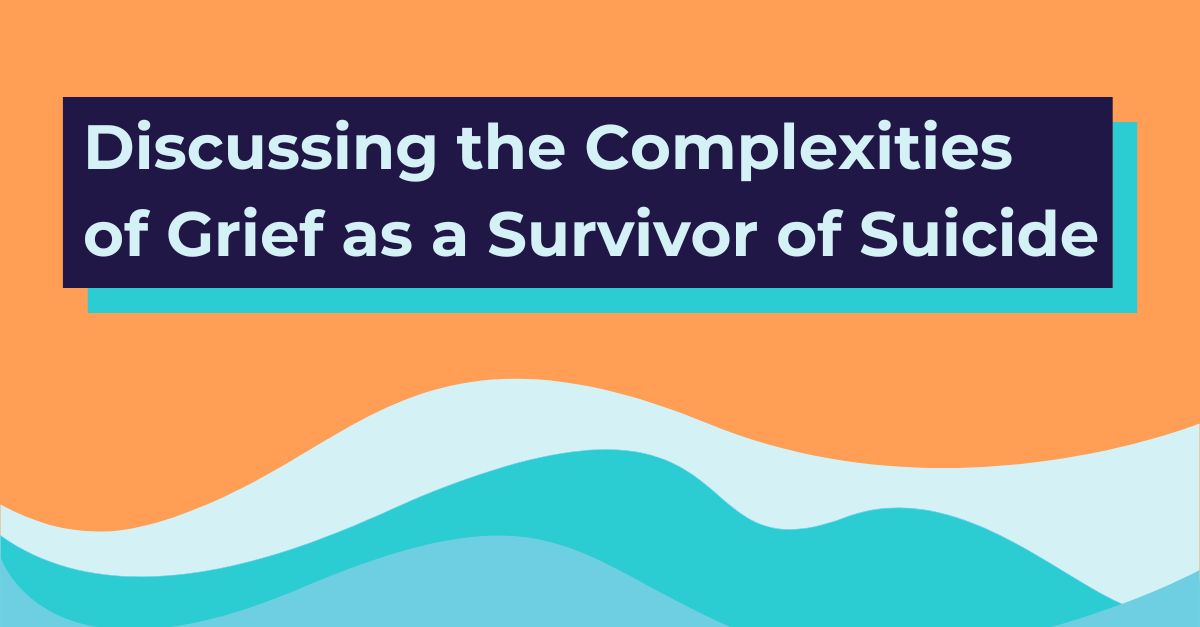November 18th, 2022

Death is an occurrence that will touch all of us at one point in our lives, whether it is a close loved one, friend, acquaintance, or someone in the community. It may be an expected loss but sometimes it is sudden and can be tragic. In each of those occurrences, death is can be quite challenging, but the suicide of a loved one comes with its own set of complexities.
Not to be confused with a person who survived an attempt, a suicide survivor, or a suicide griever, face similar grieving challenges, but it tends to be coupled with guilt, shame, stigmas, anger, and sometimes disconnection.
“Grief is like a long valley, a winding valley where any bend may reveal a totally new landscape.” – C.S. Lewis, A Grief Observed.

Grief is defined as a deep sorrow typically brought on by the death of someone. While it refers to a state of being, it really is more of a process that can occur at the loss of anything cared for, hoped for, and loved for.
Grieving is the act of mourning and comes with a profusion of varying emotions. It is often referred to as a grief cycle or stages of grief. Elisabeth Kubler-Ross coined this process as the “five stages of grief” in her book On Death and Dying in 1969.
Those stages are denial, anger, bargaining, depression, and acceptance:
Denial may look like:
Avoidance
Procrastination
Forgetfulness
Distractibility
The need to stay busy
Declaring that you are fine
And may feel like:
Shock
Numbness
Confusion
Shutting down
Overwhelming
Stuffing feelings
Anger may look like:
Pessimism
Cynicism
Sarcasm
Irritability
Aggression/fights
Substance use
And may feel like:
Frustration
Impatience
Resentment
Embarrassment
Rage
Bargaining may look like:
Rumination
Overthinking/worry
Comparisons
Fortune telling/worst-case scenario
Perfectionism
“I should have...”/ ”If only...”
And may feel like:
Guilt
Shame
Blame
Fear/Anxiety
Insecurity
Depression may look like:
Sleep/appetite disturbance
Lack of energy
Isolation
Crying
Low motivation
Substance use
And may feel like:
Sadness
Despair
Helplessness
Shutting down
Disappointment
Acceptance may look like:
Mindfulness
Reality based
Vulnerability
Assertiveness
Coping
Communication
And may feel like:
Shock
Courage
Validation
Self-compassion
Healing
(Source: The Stages of Grief: Accepting the Unacceptable, University of Washington Counseling Center)

It is important to note that this process of grieving is not linear. You can expect to move from one emotion to the next fluidly without expectation of order. Some people may feel all the varying emotions of grief associated while others may get stuck and stagnate at one stage of grief. There is no timeframe to which one can go by and having such an expectation may cause more challenges.
With survivors of suicide, there tends to be a unique and painful feeling of responsibility that they could have prevented things, thinking “if only”. They tend to feel like they should have done something different and anticipated the loved one’s mood state to prevent the occurrence of suicide. This assumption that they could have prevented the suicide tends only to increase the guilt they may feel. Unlike diseases, old age, natural causes, or accidents, which people view as uncontrollable occurrences, survivors play back experiences and scan memories for missed clues.
While anger is a normal emotion oftentimes experienced, there may be an established love-hate relationship developed as the person who completed suicide is also the cause, reason, or “murderer” of the loved one lost (Suicidology, 2019). Typically, this anger is directed inwards toward the survivor and takes the form of guilt. Self-blame ensues while some may direct the anger at others whether it is a parent, partner, employer, or program, seeing some action they took or failed to take as a cause.

There is also still a social stigma associated with suicide. Suicide is viewed negatively by some in the general public often based on negative stereotypes and misconceptions. People may associate negative labels with the deceased often ostracizing the survivors from seeking support.
“Stigma is most often defined as a mark of disgrace or infamy; a stain or reproach, as on one's reputation. In suicide, we talk about the public and self-stigma. Both forms of stigma can separately cause social isolation, demoralization, the feeling of hopelessness, and other consequences that interfere with the previous functioning. Because of the high incidence of psychological changes after stigma, it is crucial for the bereaved to have close mental health services. But stigma is a barrier to treatment seeking.” (Kučukalić, 2017)
Additionally, some may encounter people who are well-intentioned but may say the wrong thing. It will be helpful to set boundaries and express the support that you feel will be helpful. If you are unsure of the type of support you need or maybe your typical support team cannot offer you support effectively, you may find that the refuge you need comes from other avenues.
These resources include:
Being a survivor of suicide is like being on a rollercoaster of emotions where riding is the only option. You can’t opt out as you will just be prolonging the inevitable. However, it gets better with time…well it gets a bit easier. It hurts; some days will be far worse than others but finding a therapist, a grief support group for survivors, and not shying away from your emotions can all help.
Written by: Samantha Adjekum, LCPC.
At Clarity Clinic, we have highly trained staff who specialize in therapy and psychiatry services. To learn more about how we can support your mental health, call Clarity Clinic at (312) 815-9660 or schedule an appointment today.
Our Services
Virtual/Online CarePHP and IOPAdult PsychiatryChild & Adolescent PsychiatryAdult TherapyChild & Adolescent TherapyCouples CounselingFamily TherapyGroup TherapyPsychological TestingTranscranial Magnetic Stimulation (TMS)